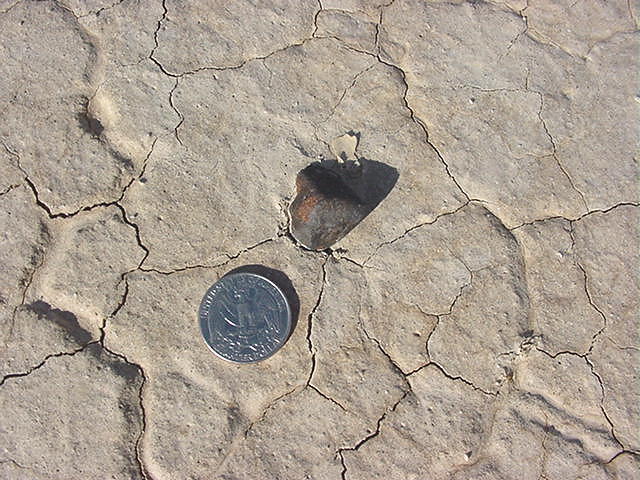Nevada Meteorite Picture of the Day
(for the Month of July 2007)
Image taken around 2003 August 2nd:

Image taken around 2003 August 2nd:

Explanation:
The above image was sent to me by the finder (back in 2003). If I hadn't renamed this image, I wouldn't even know the date-of-find for this meteorite, or that the locality is most likely Roach Dry Lake (the find locality for the Primm meteorite). All of the accompanying information that came with this image has been lost. The finder can no longer be contacted. This image is all that we have as a record of this Nevada meteorite find.
UPDATE:
After doing a little detective work, Rob Matson was able to identify the depicted stone as being Roach Dry Lake 105 (an unclassified but provisionally numbered meteorite found by Kim Cathcart).
This is just one example of how meteorites get found, but could end up becoming an undocumented find. Other examples of how meteorites could end up getting "lost to science" are:
Accidental deletion of files and messages,
Hard drive "crash",
Finder changes email address,
Finder moves or loses meteorite,
Procrastination,
and many other reasons, but most could have been averted if more prompt attention were given to (or more frequent backing-up of) data and record files.
As was hoped, by posting this image someone (Rob Matson) recognized this meteorite and contact with the finder was re-established. This find HAS been properly recorded,reported, and officially catalogued by the NomComm so that, now, this find can join the other officially recognized Nevada meteorites.
[Note: This web page has been revised to reflect this meteorite's change to "official" status.]
Now, regarding the finding of any future "new" Nevada meteorites, it is recommended that finders keep their recovery data confidential. More importantly, before "going public" by announcing a "new" meteorite find, it is highly recommended to report this information to the Nomenclature Committee (Nom Comm) of the Meteoritical Society. (See "For Reference:" below)
The reason being is that this "new" find may not really be new, but may be just the lastest of what actually are "very many" finds from a locality that the Nom Comm had been keeping confidential for a researcher, or another finder (or possibly, for many other finders). This is just one example of the confidentiality that the Nom Comm maintains, and it is called, "embargoing" a locality. Typically, this has been done for researchers who are conducting a long-term study of a locality. (The Gold Basin strewn field was studied for ~5 years before it went public.) Who knows what locality is the "next Gold Basin", or worse, is a strewn field that is currently under study. No one wants to be labeled as "the guy who blew the cover and ruined the 'next Gold Basin' strewn field"!
So, it is for this, and several other good reasons, why it is important to report your finds in a timely manner to the Nom Comm. You don't need to be a member of the Meteoritical Society in order to do this reporting. In fact, the Nom Comm prefers that the finders, themselves, report each of their Nevada meteorite finds. The minimum information they require is 1) Date of find, 2) Mass of find, and 3) Location of find. With this minimal information you can then have a Provisional Name and/or Number assigned to your find. Yes, that's right. Your find doesn't need to be classified in order to get a Provisional number. The NomComm will keep this "information" strictly confidential - AS THEY ALWAYS HAVE, for every finder that has contacted them.
For Reference:
To Report a New Nevada Meteorite: - use Meteoritical Society - Nomenclature Committee web form
Meteorite finds (from North America) can now get "Provisional" numbers assigned to them. These are assigned by the Nomenclature Commmittee (NomComm) of the Meteoritical Society. In the past it wasn't always possible to get a "provisional" name or number, so in the future this may be subject to change. But for now, given the glut of meteorite finds and the long delay in getting classifications, it has been recognized that it is better to provisionally record a meteorite find (now) than it is to wait for ALL the required information (years later). And as is the current trend, where there are more and more important meteorites being found and are in need of being studied, it has been recognized that there are even that many more Ordinary Chondrite finds being made, and not only are they going "unstudied", they are going "unrecorded"! So, in order to not lose this data, the NomComm is accepting recovery information directly from meteorite finders and issuing to them "provisional" numbers. Clearly this policy is borrowed from the NWA provisional numbering process and is only intended to be a stop-gap measure until the glut of Ordinary Chondrite finds from North America subsides (if ever). So, if you have found a another Nevada meteorite and would like to report it (from a known locality that has a formal name), you can request a "provisional" number by contacting the Editor of the Meteoritical Bulletin.
Authors & editors: Robert Verish (Meteorite-Recovery Lab)